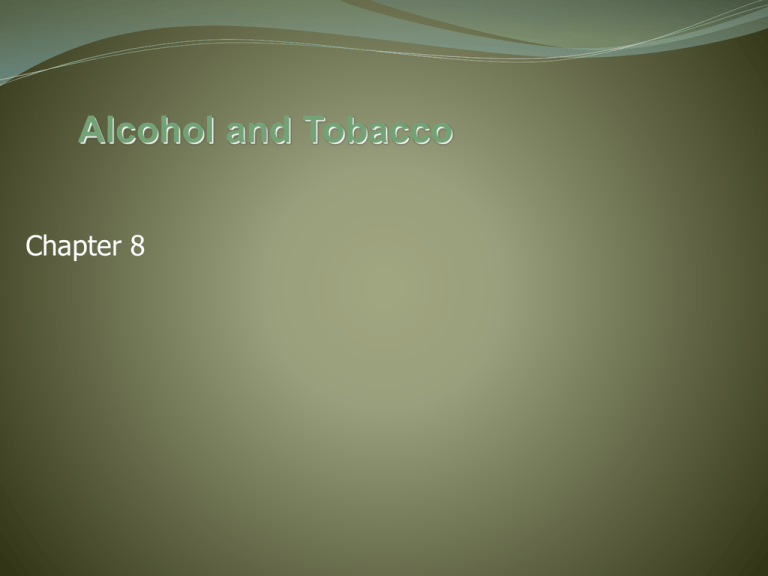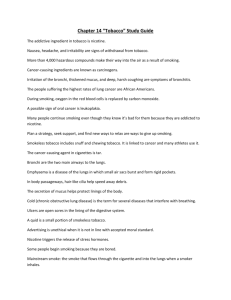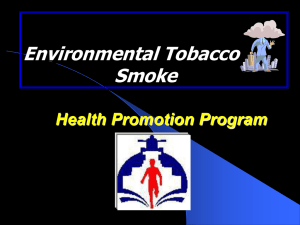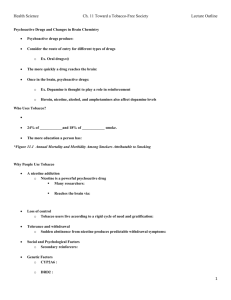
Alcohol and Tobacco
Chapter 8
Use of Tobacco
Why People use Tobacco
71 Million Americans, including 13.7 million college-aged
Americans.
2008, nearly 21% of Americans age 18 describe themselves as
current smokers.
Nicotine Addiction
Powerful psychoactive drug
Reaches Brain via bloodstream in seconds
Most physically addictive of the psychoactive drugs.
Loss of control
Tolerance and Withdrawal
http://www.youtube.com/watch?v=zRQVqlXhN5c
© 2010 McGraw-Hill Companies. All Rights Reserved.
2
Social and Psychological
Factors
Established habits or cues to trigger smoking
Secondary reinforcers.
Genetic Factors:
Specific Genes
CYP2A6 –
influences the way in which nicotine is metabolized
People with slow CYP2A6, nicotine remains in the
system longer
DRD2
Associated with brain chemical dopamine
© 2010 McGraw-Hill Companies. All Rights Reserved.
3
Why Start in the First Place?
Children and teenagers make-up 90% of all new smokers in
this country.
Thousands of children and adolescents (12-17) start smoking
everyday.
Average age
13 for smoking
10 for spit tobacco
© 2010 McGraw-Hill Companies. All Rights Reserved.
4
Characteristics which could
increase the potential for use.
A parent or sibling uses tobacco
Peers use tobacco
Child comes from blue-collar family
Child comes from low-income home
Single parent.
Performs poorly in school
Child drops out of school
Has positive attitudes towards tobacco
© 2010 McGraw-Hill Companies. All Rights Reserved.
5
Health Hazards
Contains hundreds of damaging chemical substances,
including acetone (nail polish remover), ammonia,
hexamine (lighter fluid), and toluene (industrial
solvent).
Unfiltered cigarettes = 5 billion particles per cubic mm
50,000 times more than polluted urban air
Condensed particles in the cigarette produce the tar
(brown, sticky mass)
Chapter 8
©2008 McGraw-Hill Companies. All Rights
Reserved.
6
Health Hazards (cont)
Carcinogens and Poisons
43 chemicals are linked to cancer (Carcinogen)
Benzo(a)pyrene (yellowish tar)
Urethane (ex: solution used in making foams)
Cocarcinogens
Combine with other chemicals to cause cancer (e.g., formaldehyde)
Poisonous substances
Arsenic (e.g., insectides and weed killers)
Hydrogen cyanide (e.g., flammable liquid used in dye)
Carbon monoxide
400 times greater than is considered safe in industrial workplaces
Displaces oxygen in red blood cells
Additives
Nearly 600 chemicals
Chapter 8
©2008 McGraw-Hill Companies. All Rights
Reserved.
7
“Light” and Low-Tar Cigarettes
Low-tar, low-nicotine, or filtered cigarettes
No such thing as a safe cigarette
Often smoke more
© 2010 McGraw-Hill Companies. All Rights Reserved.
8
Menthol Cigarette
70% of African Americans smoke these
Absorb more nicotine and metabolize it slower
Anesthetizing effect of menthol, inhale more deeply
and hold smoke longer in the lungs
© 2010 McGraw-Hill Companies. All Rights Reserved.
9
Immediate Effects
Acts on the brain either by exciting or
tranquilizing the nervous system
Mild nicotine poisoning
Stimulates the cerebral cortex
Stimulates the discharge of adrenaline
Physiological effects on the body
© 2010 McGraw-Hill Companies. All Rights Reserved.
10
Figure 8.4 The short term effects of smoking a cigarette
© 2010 McGraw-Hill Companies. All Rights Reserved.
11
The Long-Term Effects
Cardiovascular Disease
Coronary Heart Disease (CHD)
Atherosclerosis
plaques
Angina pectoris
Myocardial infarction
Stroke
Aortic aneurysm
Pulmonary heart disease
Lung and other cancers
Benzo (a) pyrene (yellowish tar)
Chronic Obstructive Lung Disease (COLD)
Emphysema
Chronic Bronchitis
© 2010 McGraw-Hill Companies. All Rights Reserved.
12
Additional Health, Cosmetic,
and Economic Concerns
Ulcers
Impotence
Reproductive health problems
Dental diseases
Diminished physical senses
Injuries
Cosmetic concerns
Economic costs
© 2010 McGraw-Hill Companies. All Rights Reserved.
13
Cumulative Effects
Males before 15 yrs. old are half as likely to live to 75
versus those who did not smoke
Females with similar habits reduce life expectancy by
more than 10 years
Female smokers spend 17% more sick days in bed
than nonsmokers
Both men and women show a greater rate of acute
and chronic diseases
© 2010 McGraw-Hill Companies. All Rights Reserved.
14
Other Forms of Tobacco
Spit (Smokeless) Tobacco
More than 6.6 million adults
8% of all high school students
Cigar and Pipes
Cigar smoking has increased by 148% from 1993-2006.
Cigars contain more tobacco than cigarettes.
Clover cigarettes and Bidis
Twice the tar, nicotine, and carbon monoxide
© 2010 McGraw-Hill Companies. All Rights Reserved.
15
© 2010 McGraw-Hill Companies. All Rights Reserved.
16
The Effects of Smoking on the
Nonsmoker
Environmental Tobacco smoke (ETS)
Environmental Protection Agency (EPA) designated
ETS as a class A carcinogen
Department of Health and Human Services’ National
Toxicology Program - “known human carcinogen”
Surgeon General – 2006 – “there is no safe level of
exposure to ETS; even brief exposure can cause serious
harm”.
© 2010 McGraw-Hill Companies. All Rights Reserved.
17
Environmental Tobacco Smoke
Mainstream smoke
Smoke exhaled by smokers
Sidestream smoke
Smoke from the burning end of a cigarette, cigar, or pipe.
85% of smoke in a room is second hand
Twice the tar and nicotine
Three times the benzo(a)pyrene
Three times the ammonia
Smoke from a cigar can be even more dangerous
30 times more carbon monoxide
© 2010 McGraw-Hill Companies. All Rights Reserved.
18
ETS Effects
Develop cough, headaches, nasal discomfort, eye irritation,
breathlessness and sinus problems
Allergies will be exacerbated
Causes 3,000 deaths due to lung cancer
Contributes to about 35,000 overall deaths each year.
20% increase in the progression of atherosclerosis.
Contributes to increased asthma attacks
© 2010 McGraw-Hill Companies. All Rights Reserved.
19
Lung Cancer from Tobacco Smoking
© 2010 McGraw-Hill Companies. All Rights Reserved.
20
Oral Cancer from Tobacco Smoking
© 2010 McGraw-Hill Companies. All Rights Reserved.
21
Oral Cancer from Tobacco Smoking
http://www.youtube.com/w
atch?v=0hySFt8O11A
© 2010 McGraw-Hill Companies. All Rights Reserved.
22
Infants, Children, and ETS
More likely to develop
Bronchitis, pneumonia,& respiratory infections
More complications from asthma
Increased chance of SIDS
Low-birth weight
Bronchitis
Chemicals from smoking show up in breast milk
Children inhale three times more pollutants per unit of body
weight than adults.
© 2010 McGraw-Hill Companies. All Rights Reserved.
23
Smoking and Pregnancy
Estimated 4,600 infant deaths in the U.S.
Miscarriage, premature birth, low birth weight,
long term impairments in growth and intellectual
development
Possible higher risks of getting cancer
16% of pregnant women smoke
© 2010 McGraw-Hill Companies. All Rights Reserved.
24
Cost of Tobacco Use to Society
Lost productivity from sickness, disability, and
premature death makes it close to $167 billion per
year.
1998 Master Settlement Agreement (MSA)
43 states filed suit against tobacco companies to
recoup public health care expenditures
Tobacco companies have to pay $206 billion over 25
years.
Limits or bans certain types of advertising,
promotions, and lobbying.
© 2010 McGraw-Hill Companies. All Rights Reserved.
25
What Can Be Done?
Action at the Local level
Action at the State and Federal level
Food and Drug Administration (FDA)
Environmental Protection Agency (EPA)
Occupational Safety and Health
Administration (OSHA)
International Action
World Health Organization (WHO)
Action in the private sector
Individual Action
© 2010 McGraw-Hill Companies. All Rights Reserved.
26
How A Tobacco User Can Quit
50.2 % of all adults who have smoked have quit.
The Benefits of Quitting (See Table 8.5)
Options for quitting
Smoking cessation programs
1-800-QUITNOW
Smoking cessation products
Department of Health and Human Services
Chantix (Varinicline)
Zyban (Bupropion)
Nicotine replacement products
Patches, gums, lozenges, nasal sprays, and inhalers
http://www.videojug.com/interview/the-benefits-of-quitting-smoking-2
© 2010 McGraw-Hill Companies. All Rights Reserved.
27
Connect Assignment
Chapter 8 Connect Assignment (Tobacco) Due
Tuesday, March 9th
© 2010 McGraw-Hill Higher Education. All rights reserved.
Alcohol and Tobacco
Chapter 8








